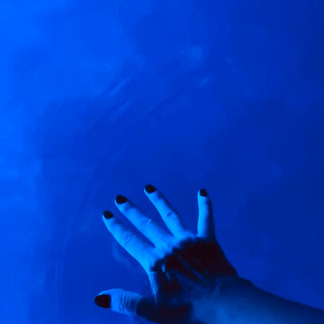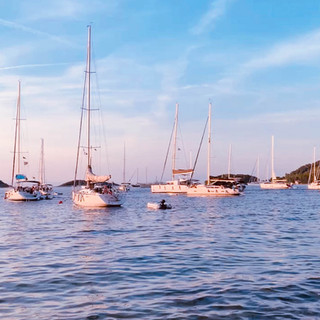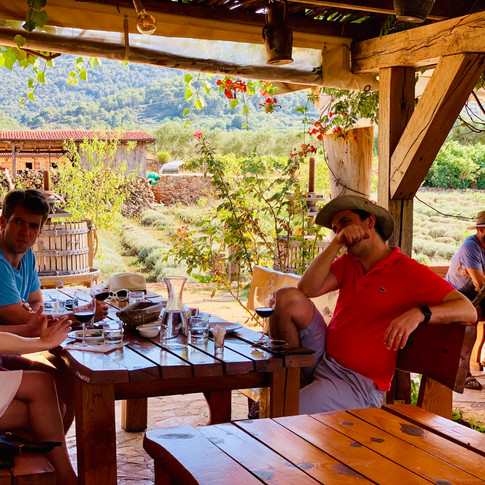An Oenophile's Dalmatian Sailing Itinerary
- Sophie Griffiths
- Aug 13, 2019
- 9 min read
The Wine-Dark Sea

This is essentially the post I wish I could've found whilst planning our two week sailing trip: how do I combine the best swimming spots on the most secluded islands, while maximising opportunities for excellent restaurants and wine experiences, without too many long sails (over 4 hrs)? So here it is. You can thank me later.

Croatia is not (yet) renowned for its food and wine culture. A traumatic recent past means that it doesn't really benefit from the same romantic, hedonistic associations that draw people to its maritime neighbour, Italy. Even though it shares so much of the same raw ingredients in terms of climate, landscapes, flora and fauna.
The unfamiliar language is also a barrier, but of course, lucky us, everyone speaks English, and it's worth getting past that to enjoy a part of the world that still feels somewhat untouched and undeveloped, especially taking Italy as our comparison again.
Croatia's wine scene is at an exciting moment. The intoxicating Star Grad plains of Hvar are one of the oldest and longest cultivated areas of the Mediterranean, yielding lavender, olives and vines since the Greeks. Croatia boasts 200 grape varieties, with 120 indigenous ones, apparently thanks to so many undisturbed nooks and crannies where native varieties have survived unmolested by the homogenising force of international wine trends.
Briefing: Key Croatian Grapes
Croatian White Grapes:
Graševina. Pronounced Grashevina. As Croatia's wine credentials continue to grow, many believe this could become their signature white grape. Largely grown in the inland area known as Slavonia (not to be confused with Slovenia... which is a totally different country). Slavonia has also been a key source of oak for traditional old Italian Botte - those massive casks, commonly used in winemaking in Northern Italy.
It's surprisingly full-bodied which belies its citrussy freshness and often mineral edge. A touch of bitter almond, chamomile and lots of green apple.

Pošip: Pronounced Poship. Originally from Korčula (Kor-chu-la) island. As one waiter told us, and we obeyed: "If you have seafood here in Dalmatia, you have to drink Pošip". Aromatic, crisp, also full-bodied with notes of apricots, almonds, apple.

Malvazija Istarka: (Pronounced like Malvasia) is grown further north around the Istrian peninsula, (directly east of Venice). I learnt this wine is sometimes aged in acacia wood or amphorae with some skin contact, so you can find very complex, textured examples. Lovely salinity and viscosity, with fresh notes of fennel and apricot. Of course also great with seafood.

Grk: Good luck pronouncing that. It sounded something like 'gerk'? Also indigenous to Korčula, this white grape is apparently genetically related to Crljenak kaštelanski - better known as Primitivo, or perhaps even better known as Zinfandel. A weighty aromatic wine with good acidity. Cebalo is one of the leading producers of Grk we tried and it's richness stood up well to a very indulgent lobster pasta.
Croatian Red Wines:
One of the better known factoids about wine and Croatia is that California's flagship Zinfandel, aka Southern Italy's flagship Primitivo, is actually traced back to Croatia, aka Crljenak kaštelanski, or Tribidrag.

However the red wine that gets the most critical acclaim here is Tribidrag's genetic cousin, Plavac Mali, another native Croatian. Grown in the warmer climes of Southern Dalmatia it's a beautifully heady, spicy wine with powerful notes of pepper and cacao. You may also see Rosé's made from Plavac Mali; just don't expect them to be in the anaemic Provençal style!
Wonderful with slow cooked lamb, which you sometimes see as a local delicacy. Matusko, from the Dingac region, is one of the leading producers of Plavac Mali.
And finally.... something sweet
Sadly you don't see them very often down in Dalmatia but keep your eyes peeled for Noble Rot (Botrytised) or ice wine style dessert wines made inland in continental Croatia (Slavonia), especially from the grape Graševina. A notable producer is Galić. If you come across it, be sure to order it!
A Two-Week Dalmatian Sailing Itinerary for Wine Lovers
Day 1: Rogoznica to Paklinski Archipelago

Set sail to St Klement Island, Palmizana bay, part of the Paklinski archipelago of pine tree and rosemary-covered islets. ACI Palmizana Marina is expensive (thanks to the proximity to Hvar Town) but the benefit is you get to eat at Zori Restaurant. You can see my Zori write up here. Head left out of the Marina, walking over the hill and you'll find it. Great cocktails (including a gourmet G&T menu), a diverse selection of tasting menus with paired wines, exceptional staff and one of the best wine lists we found, featuring the fabulous boutique producer Galić.
Day 2: Paklinski Archipelago to Komiza, Vis Island, via Budikovac

After exploring Paklinski archipelago, sail onto Budikovac, a small island with a beautiful lagoon off the island of Vis. Then sail on to either anchor or take a mooring buoy overnight in Komiza, a small town on the south west coast of Vis. A really sweet little town of crumbling Venetian buildings and a great point to explore the Blue Caves the next day. Local lobster is the specialty at old lobster-pot house, Konoba Jastožera which is hoisted above the water's edge, with space to tie your tender up underneath the restaurant.
Lots of vines are cultivated on the island, and a great local wine is Vugava, especially from a good local producer called Lipanovic.
Day 3: Komiza to Vis Town
Take a tourist boat to see the Blue Caves; on a little islet just south of Vis. You can sail yourself, but it's easier to do it on an organised tour, as even when you get to the Blue Caves area you can only enter on an organised tour. By doing it from Komiza, you get preferential access / fast lane, to get into the Blue Cave on one of the small boats that are allowed in. The Blue Caves are a natural wonder, where in the middle of the day, sunlight refracts into the cave through an unseen crack, reflecting off the sand and creating a stunning blue light. When you're inside the dark cave it's as if the water has been lit with powerful blue uplighters.
The effect is so artificial it almost seems an unimpressive sight. We're so used to seeing swimming pools glowing a luminous blue at night time; you have to remind yourself, we're in a cave and this is natural light! As far away as Dubrovnik and Hvar, we saw signs for tours that will take you to the Blue Caves by speed boat. My advice? If you come to Komiza, definitely don't miss it. In 20 minutes you're there, via a rather thrilling, white-knuckle rib ride, a short wait in line, a quick gawp inside the cave (you can't stay long in the cave, perhaps you get 5 minutes before you're whisked away, and others come in, and for safety reasons you can't swim), and then back again on the rib. You're done in 1.5 - 2 hours, max. I think from further afield, the travel time may rather outweigh this humble natural wonder.
After this, sail clockwise around the island and anchor up in Vis town, on the north side of the island. This is a buzzy little town and from here you can visit some cute nearby wineries by taxi (call ahead to check).

I also highly recommend a cocktail at Bistro Frutarija, sitting directly on the dock side, to watch the sun set and listen to the town bells chiming.

Day 4: Vis Town to Hvar Town, Hvar

Book ahead or head into Hvar town very early if you want to get a mooring buoy or a place on the town quay.
Hvar is said to be like the St Tropez of the Adriatic and it does live up to that - the good and bad. Beautiful architecture and stunning seaside location. But also busy, showy, pricy (not St Tropez levels yet, of course, but compared to other places in Dalmatia) with many big, shiny stink-boats to ogle.
For a picture-perfect setting, try Divino Restaurant at sunset. It's pricy (it's the type of restaurant with a concept gift shop attached) but the food is excellent; fresh pasta with truffle, and fresh pasta with insanely good, melt-in-the-mouth prawns.
A great wine list and the setting is perfect as you sit on a raised rooftop terrace, with a stone balustrade and Romanesque stone pillars, looking out into the harbour and the flashy yachts, so it does a great job of synthesising the various elements you want from your Hvar experience!

I also recommend hiring a car and driving into the heart of Hvar island; the Stari Grad plains. This is a now Unesco World Heritage site, and is the longest continually cultivated plain in the Mediterranean. Since the Greeks, it's been a fertile valley full of vines, lavender groves and olive trees. The sounds of the cicadas is defeaning, and the dry, herbal scent of the air is wonderful.
We missed out on visiting Ivo Dubokovic in Jelsa, a boutique winemaker, but this would be my recommendation based on industry buzz and what I've read, if you want to visit a serious winemaker and taste some internationally acclaimed wines. Call to book ahead.
We went to a place we stumbled upon called Hora and had a rather more tourist-led experience, but it was still a perfect way to spend the afternoon in the most idyllic, lavender-scented setting, right in the middle of the Stari Grad plains.
Day 5: Hvar to Zaklopatica Bay, via Vela Luka Bay.

Leave the hustle of Hvar and head for the peace and remoteness of Lastovo, entering the National Park. Nip into Vela Luka Bay on your way down from Hvar for a swim and lunch on board.
Then head onwards to the dreamy Zaklopatica Bay on the Island of Lastovo.
Eat the lobster pasta with a bottle of Pošip, while watching the sunset at the incomparable Augusta Insula. I mean just look at that sunset! That is what happened when I reduced the exposure on the photo; no other photo processing required to bring out these incredible colours. See my write up here.

Day 6: Zaklopatica Bay, Lastovo, to Polace Bay, Mljet, via Lastovnjaci Archipelago
From Lastovo head towards the island of Mljet via the Lastovnjaci archipelago where you can anchor up for lunch and a snorkel. Overnight in Polace Bay, at Joseph's restaurant and expect Michelin-star style service in the most basic looking restaurant. See my write up here.
Day 7: Polace Bay, Mljet to Dubrovnik, via Sunj Bay, Lopud.
Today, make like Danaerys and head to King's Landing, I mean, Dubrovnik. A nice lunch and swim stop-off is Sunj bay, a sandy beach on Lopud island. I believe it's possible to anchor up in the old town of Dubrovnik, but we couldn't work that out and ended up booking into Marina Frappa, just to be assured of a spot. A sparkling new marina and just a short taxi ride over to Dubrovnik old town. Plenty of restaurants to choose from here; be sure to book in advance.
The top restaurant is Nautika, with a great setting looking down over one of the old bays, just outside the atmospheric city walls. We ate at a restaurant in the old town called Proto, pricy but some of the food was exceptional and the wines were great especially a Croatian Sparkling wine which was a real surprise. However if I went again I would book ahead into Nautika.
Be sure to allow time to find a good spot on a city wall somewhere to watch the sunset and then get completely lost in the windy streets, pretending to be Arya on the rampage.

Day 8: Dubrovnik to Okuklje Bay, via Saplunara Bay

Time to start winding your way back towards the north. From Dubrovnik, Saplunara Bay is a good lunch and snorkel stop off, before anchoring further up in Okuklje Bay overnight.
We ate at one of the local restaurants in return for a mooring, but it was nothing special, hence I'm not covering it.
Day 9: Okuklje Bay to Korcula Town

From Okuklje Bay to Korcula town on Korcula island, the alleged hometown of Marco Polo and one of the best preserved medieval towns in the Mediterranean. While its credentials as birthplace of Marco Polo are spurious, it is the birthplace of the native grape Posip, which pairs perfectly with the local seafood. This is a good island to explore some wineries and my recommendation based on what we drank would be the small family winery Nerica, who are responsible for bringing back Korcula island's first Decanter Gold Medal for their Pošip.
Dinner at Nigra is a winner (which features Nerica other wine list), as I recommended in my top 5 blog post.
It has a waterside terrace looking back onto the picturesque old town on Korcula bay with a small but perfectly-formed wine list.

Day 10: Korcula Town to Otok Šćendro, via Loviste Bay.

A gentle sail up to Loviste for a swim before heading onwards to protected nature reserve, Otok Šćedro, a tiny islet just off the south coast of Hvar. There are so many little bays if you persevere you're likely to find one just for yourself.
There are some bays with bookable mooring buoys if you want to go ashore to eat, otherwise this is a nice secluded place to stay aboard and concoct a delicious dinner to clear out your fridge!

Day 11: Otok Šćendro back to Paklinski Archipelago
Back towards Rogoznica, but time for a final stay over night on the Paklinski Archipelago. The Fisherman's House, one of my top 5, is an absolutely perfect way to round off a fortnight of incredible experiences. Maximise those Robinson Crusoe vibes and enjoy perfect seafood before going reluctantly back to civilisation.
Day 12: Back to base
A gentle sail back into port. For us, this was back round to Rogoznica, but for others this may be back into Split. With an extra sailing day, perhaps checking out Brac or Bol.
Finer details:
We picked up our boat in Rogoznica, a 30 min taxi from Split airport, and had a 12 day sail. This itinerary could also work from Split, for 12-14 days. In which case at the beginning or the end you might like to add on Zlatni Rat and Brac on your way out from, or back to Split, which this itinerary misses out, in the interests of keeping a relaxed pace and ensuring plenty of time for swimming and snoozing!
We chartered through Ban Tours (brilliant - very generous towel/linen allocation; always a key ingredient for a luxurious experience aboard!) via the excellent UK-based agent Helm, through whom we've had excellent charters in the Ionian, Cyclades, and Sardinia.
















































Comments